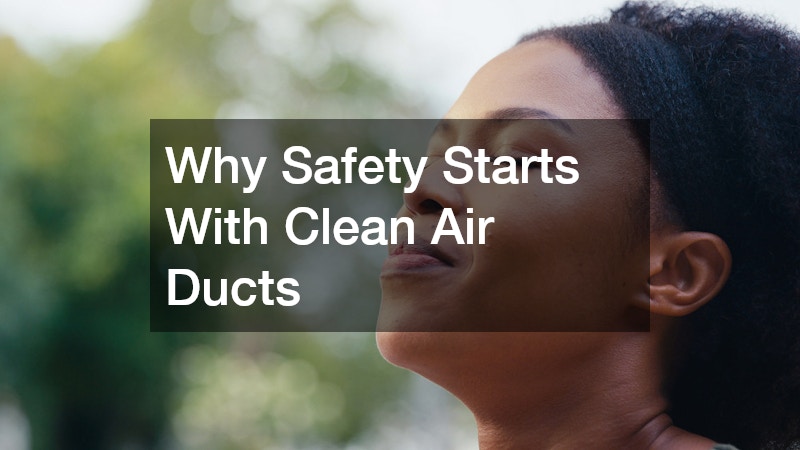
Why Safety Starts With Clean Air Ducts
Ensuring the cleanliness of air ducts is not merely a matter of maintaining an orderly living or working environment; it is a critical component of safeguarding health and safety. The quality of the air we breathe indoors is intrinsically linked to the state of our air ducts, a connection often overlooked in discussions about air quality. Establishing a routine of using regular air duct cleaners can significantly improve life quality by mitigating risks associated with poor air quality.
How Do Dirty Air Ducts Affect Indoor Air Quality?
Dirty air ducts play a substantial role in diminishing indoor air quality, negatively affecting the health of those residing or working within a space. When contaminants like dust, mold, and pollutants accumulate in neglected air ducts, these particulates become airborne and circulate throughout the environment, exacerbating health issues.
This circulation of pollutants has been linked to an increase in allergies, asthma attacks, and other respiratory conditions, illustrating a clear need for regular duct cleaning to protect health.
Exposure to these airborne pollutants can also weaken the immune system over time, leaving individuals more susceptible to various infections and diseases. In places like schools, offices, and homes, where people spend the majority of their time, the constant exposure to these irritants becomes a serious concern. Ensuring that air ducts are clean and free from obstructions can dramatically improve the air quality, thereby reducing health risks. Fact: Approximately 40 pounds of dust are created annually in a typical home through everyday living, which can circulate if ducts are not regularly cleaned.
Air ducts not only circulate air; they also serve as conduits for the spread of allergens and pathogens. Over time, particles such as pollen, dander, and bacteria can build up within the duct system and repeatedly expose occupants to them with every cycle of the HVAC system. This internal environment, if not addressed, can become a breeding ground for health issues, making the cleaning of air ducts an essential practice for anyone concerned with maintaining a healthy living or working space.
What Are the Signs Your Air Ducts Need Cleaning?
Recognizing the signs that air duct cleaning is necessary can be a key factor in preventing potential health and safety hazards. One of the most common indicators is the presence of unusual odors emanating from the HVAC system, suggesting mold or mildew accumulation within the ducts. If these odors are prevalent, it may be time to inspect the ducts for underlying issues and consider a thorough cleaning to restore a safe environment.
Another telling sign of dirty air ducts is the visible accumulation of dust and debris on surfaces and vents. This accumulation suggests blockages or contaminants within the ducts that are not being effectively filtered, leading to potential system inefficiencies. When there’s an increase in dust or particles visibly circulating in the air, it usually points towards a need for immediate cleaning and maintenance.
The inefficiency of heating or cooling systems is another clear indicator that air ducts require attention. Blockages caused by grime or debris can lead to significant disruptions in airflow, causing these systems to work harder than necessary and potentially leading to malfunctions. Monitoring such inefficiencies can save on energy bills and help identify issues before they become serious problems, underscoring the importance of regular duct cleaning.
How Can Clean Air Ducts Enhance Safety?
The role of clean air ducts in enhancing safety is often underestimated, but it is critical for preventing fire hazards. Dust and debris build-up within ducts can pose a severe fire risk, as such accumulations can ignite under the right conditions. Regular duct cleaning removes these threats, reducing the potential for devastating fires that threaten lives and properties.
Beyond fire hazards, clean ducts also play a pivotal role in preventing system failures that could lead to dangerous conditions like carbon monoxide leaks. HVAC systems under undue strain from clogged ducts can malfunction, increasing the risk of releasing this odorless, poisonous gas into the living or working environment. Proper maintenance and cleaning of ducts ensure that these systems operate correctly, safeguarding against such hazards.
The safety benefits of maintaining clean ducts are substantiated by decreased energy consumption, as clean systems function more efficiently without the obstacles of dust and debris. This efficiency not only cuts down on utility expenses but also ensures that all components operate within safe parameters, reducing the need for emergency repairs or replacements. By prioritizing regular air duct cleaning, individuals can proactively maintain safety and comfort in their environments.
The significance of clean air ducts goes beyond aesthetics and convenience; it fundamentally impacts health and safety. The discussion has highlighted the critical link between dirty air ducts and issues such as health problems and inefficiencies in climate control systems, which collectively underscore the necessity of regular maintenance. Prioritizing the cleaning of air ducts is a proactive measure, integral to ensuring ambient air quality and safeguarding the well-being of occupants in both residential and commercial settings.
.


